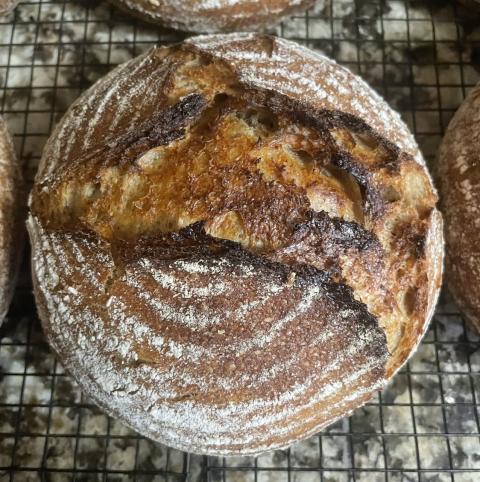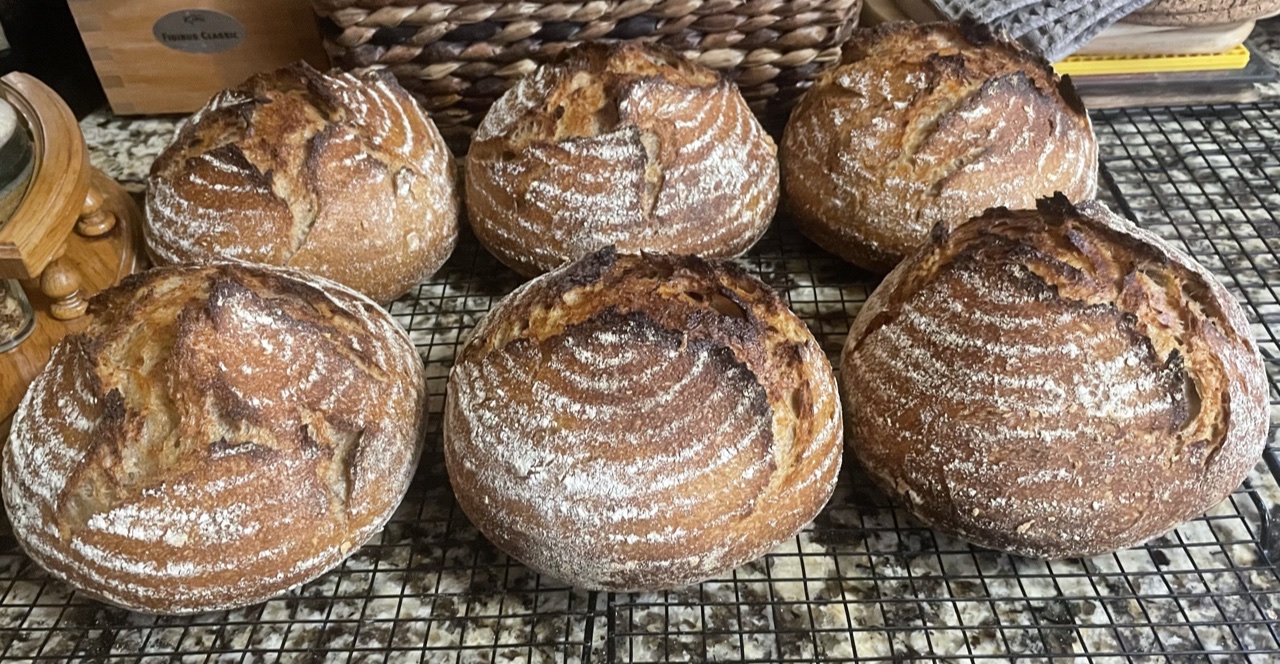
Rustic Rye Sourdough

I have a lot of rye berries in stock and I haven’t used a lot of it lately. So a rustic light rye was in order for this weekend. My inspiration is from this site: https://heartbeetkitchen.com/rye-sourdough-bread-recipe/. I changed just about everything in the recipe method wise except for the proportions of ingredients (Note that I did add yogurt and upped the salt to 1.8%). Hopefully my loaves turn out as well as the original recipe.
Recipe
Makes 3 loaves
737 g of filtered water
760 g strong baker’s unbleached flour
200 g freshly milled rye flour
112 g freshly milled Selkirk flour (whole grain wheat flour)
42 g honey
30 g whole milk yogurt (locally sourced)
22 g pink Himalayan salt
250 g levain (procedure in recipe)
Extra rye and unbleached flour
The day before:
1. About 8 hours before bedtime, take 2 g of refrigerated starter and feed it 4 g of filtered water and 4 g of wholegrain rye flour. Let sit in a warm spot.
The night before:
- Mill the Selkirk and Rye berries if using, on the finest setting of your mill or measure out commercial whole grain rye and whole grain wheat flour if you don’t mill your own.
- Place the required amount of each freshly milled flour in a tub and add the unbleached flour to it. Cover and set aside.
- Feed the levain 20 g of water and 20 g of wholegrain flour. Let it rise at room temperature for the night.
Dough making day:
1. Feed the levain 100 g of filtered water and 50 g of rye flour as well as 50g of strong baker’s flour. Place in a warm spot. Let rise until doubled (about 4-5 hours). The levain is a fairly stiff one due to the freshly milled rye flour even though it’s 100% hydration.
2. About two hours before the levain is ready, using a stand mixer, mix the water with the flours, and mix on speed 1 until all the flour has been hydrated. Let this autolyse for a couple of hours.
3. Once the autolyse is done, add the salt, the yogurt, the honey and the levain to the bowl. Mix on speed one for a minute to integrate everything, then mix on speed 2 for 9 minutes.
4. Remove the dough from the mixing bowl and place in a lightly oiled covered tub. Let rest 30 minutes in a warm spot (oven with light on).
5. Do 2 sets of coil folds at 30 minute intervals and then 2 other sets at 45 minute intervals, and then let the dough rise to about 40-50%. It should have irregular bubbles visible through the sides of the container and quite a few large bubbles on top as well.
6. Tip the dough out on a bare counter, sprinkle the top with flour and divide into portions of ~725 g. Round out the portions into rounds with a dough scraper and let rest 30 minutes on the counter. I was surprised that this dough was not sticky considering the amount of rye in it.
7. Do a final shape by flouring the top of the rounds and flipping the rounds over on a lightly floured counter. Gently stretch the dough out into a circle. Pull and fold the third of the dough closest to you over the middle. Pull the right side and fold over the middle and do the same to the left. Fold the top end to the center patting out any cavities. Finally stretch the two top corners and fold over each other in the middle. Roll the bottom of the dough away from you until the seam is underneath the dough. Cup your hands around the dough and pull towards you, doing this on all sides of the dough to round it off. Finally spin the dough to make a nice tight boule.
8. Sprinkle a mix of rice and all purpose flour in the bannetons. Place the dough seam side down in the bannetons. Let rest for a few minutes on the counter and then put to bed in a cold (38F) fridge overnight. I try to keep this between 10 and 11 hours.
Baking Day
1. The next morning, heat the oven to 475F with the Dutch ovens inside for 45 minutes to an hour. Turn out the dough seam side up onto a cornmeal sprinkled counter. Place rounds of parchment paper in the bottom of the pots, and carefully but quickly place the dough seam side up inside.
2. Cover the pots and bake the loaves at 450 F for 25 minutes, remove the lids, and bake for another 22 minutes at 425 F. Internal temperature should be 205 F or more.
I’m quite happy with the look of these loaves. We will see what the crumb is like when we cut into one.



Comments
The second one I cut into has a more regular crumb.
Beautiful loaves and that crumb is perfect!
curious... do you use a regular or Greek yogurt?
made by a local dairy. You definitely could use Greek yogurt if you wish. The local yogurt is full fat and I add it to tenderize the crust. Friends were complaining that the crust was tough and I found that adding yogurt, even if it’s a tiny amount, made a huge difference. I think i was trying to use up some left over yogurt or kefir at one point and that’s how it all started. You can totally skip the yogurt and it won’t affect the recipe.
And thank you for the compliment!
I bet these must have tasted great. I like the sweetness honey adds to a loaf versus sugar and never use plain white sugar in bread but will use honey sometimes or agave syrup.
Happy Baking Danni😎
That's a lot of bread though. How many loaves can you bake at a time?
Dutch ovens so I do 6 at a time. I bake a total of 12 since that what I have the equipment for and the room in the fridge.